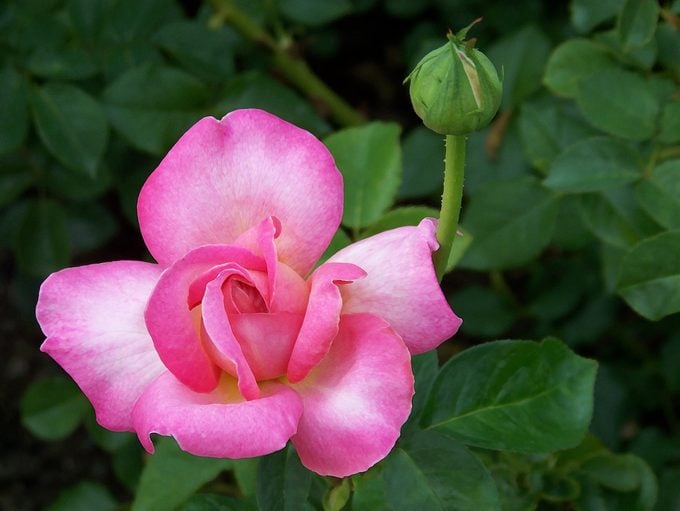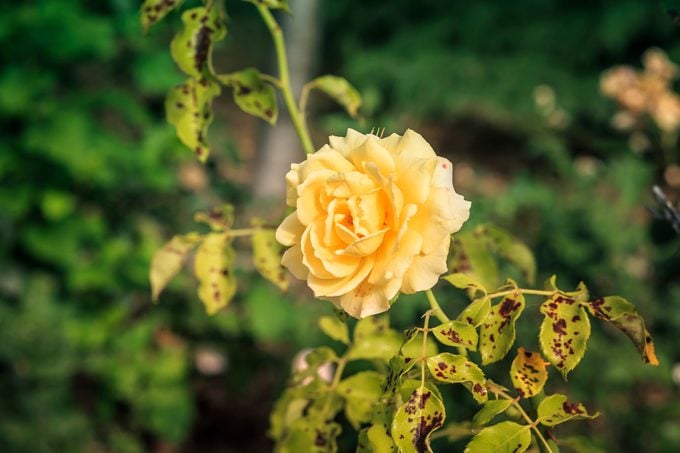How to Treat Black Spot and Rose Rosette Disease
Updated: Jul. 22, 2024
Are your roses looking a little sick? Get expert advice on how to handle rose rosette disease, black spot on roses and botrytis blight.

It’s early spring, and you are wandering the aisles of your favorite garden center in hopes of replacing that sickly rosebush you pulled from the garden late last fall. That’s when you see it: a robust beauty with emerald-green foliage and bright pink blooms. Fast-forward to summer, a few months later. You see black spots on your new rosebush. Oh, no, not again! If your roses look sick, it’s likely that rose rosette disease, black spot or botrytis blight is the problem. Here’s what you need to know about these rose diseases.
Learn how to get rid of powdery mildew.
On This Page
Rose Rosette Disease
“A nursery diagnosed my Knock Out rose bushes with brooming infestation. Do I have to dig them up?” asks Birds & Blooms reader Terry Hathcock of Millington, Tennessee.
Gardening expert Melinda Myers: Brooming is when a plant produces a cluster of fine, twiggy growth that resembles a broom. This growth, excessive thorniness, enlarged canes and malformed or discolored leaves and flowers are all symptoms of rose rosette disease. This viral disease is spread from infected to healthy plants by mites.
Removing and disposing of all parts of plants infected with rose rosette disease, including the roots, as soon as it’s discovered helps reduce the risk of infecting nearby healthy roses. All types of roses appear to be susceptible to the disease and, with more roses being added to our landscapes, the disease is becoming more prevalent.
Visit roserosette.org for tips on diagnosing, preventing and controlling the disease. Report any new rose rosette disease infections to that website and your local extension service to help monitor and manage the spread.
Learn how to prepare and prune roses for winter.
Black Spots on Rose Leaves

“A rose bush that I’ve had for two years has developed black spots. What is causing this?” asks Emma Folwell of Liberty, North Carolina.
Melinda: The fungal disease called black spot is common on roses. Even resistant varieties succumb to the disease if the weather conditions are warm and wet and the fungus is present in the area. Remove infected leaves when you first spot them or as soon as they fall. Next, do a thorough cleanup in fall. Sanitation reduces the chance for disease in next year’s garden. This, along with better weather, is usually enough to prevent black spot on resistant varieties.
Once a garden is infected, though, susceptible varieties are typically prone to black spot. Fungicides labeled for controlling the disease should be applied as a preventive before the black spots appear. Use a variety of fungicides for best results, and follow the label directions carefully.
Psst—roses love garlic: find out why.
Botrytis Blight
“I have a beautiful, healthy-looking pink rosebush. However, just before the plant’s huge buds open, they become brown and disintegrate. Can you tell me why?” asks Patsy Wheeler of Durand, Michigan.
Melinda: Botrytis blight, a fungal disease, is the culprit. It can attack a variety of plants, including roses and peonies, causing the buds to turn brown and fail to open. It seems to be more prevalent on white and pink roses. Watch for this disease during rainy or humid weather. Remove the infected flower buds, place them in a paper bag and dispose immediately. Do not compost infected plant parts, because most compost piles do not reach high enough temperatures to kill the infected spores.
“My peonies and Knock Out roses are turning brown as they bloom. It looks like some sort of blight. What is going on?” asks Melanie Turner of Elberton, Georgia.
Melinda: When flower buds on peonies and roses turn brown and fail to open, it’s a common symptom of botrytis blight, also called gray mold. This fungal disease is most common in cool and rainy or humid weather. Botrytis causes bud blasts and flower blights, which can also occur in mums, dahlias, dogwoods, hydrangeas, marigolds and sunflowers. Remove the infected plant parts as soon as they are discovered and only during dry weather to avoid spreading the blight. Don’t compost the infected buds and flowers; instead place them in a paper bag for disposal to reduce the risk of spreading the disease. Ongoing sanitation, fall cleanup and better weather usually keep this disease under control.
Next, discover surprising facts about roses.




















